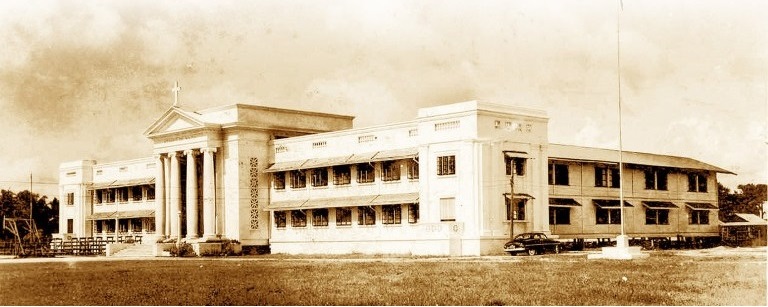
HISTORY
Ateneo is derived from “Athens”, the ancient seat of learning. Naga comes from the word narra or Philippine mahogany. Naga City, a center of religion, culture, education, and economics, is popularly known as the “Maogmang Lugar.”
Ateneo de Naga University is one of the eleven schools in the Philippines run by the members of the Philippine Province of the Society of Jesus. The main campus is located northwest of the Metropolitan Cathedral, in the barangay of Bagumbayan Sur in Naga City. In SY 2003- 2004, the high school transferred to a new campus in Pacol, now known as Bonoan Campus, located at the slopes of Mt. Isarog, seven kilometers away from the main campus. The other Jesuit schools in the Philippines are found in Manila, Cagayan de Oro, Davao, Zamboanga, Bukidnon, Cebu, San Juan, Nuvali, Iloilo and Culion.
Msgr. Pedro P. Santos, 31st prelate and first Archbishop of Caceres, invited Fr. John Hurley, S.J., then the Superior of the Philippine Jesuit Missions, to build a Jesuit school for boys in Naga. On 2 May 1940, Ateneo de Naga was founded with Francis D. Burns, S.J., as its director, aided by six Jesuits.
Classes formally started in June 1940 at the building formerly used by the Camarines Sur Catholic Academy (now Naga Parochial School) with 650 elementary and high school students. Meanwhile, Msgr. Santos initiated the construction of the Jesuit faculty house and the Ateneo school building with the now well-known four pillars. These buildings were intended to be turned over to the Jesuits on 15 December 1941. However, this plan was thwarted when the Pacific war broke out.
When the Japanese came to Naga, the Ateneo was taken by the Japanese army and became a local “torture chamber.” But as soon as Philippine Independence was declared in 1946, the high school department of the Ateneo resumed classes with Fr. Burns as Director.

On 1 June 1946, full recognition as a standard four-year high school was granted by the Department of Education to Ateneo de Naga. On 5 June 1947, a college for men was opened with 87 students. Ateneo conferred its first academic degrees in April 1950. On 26 October 1953, the Ateneo College Department became co-educational when five women were granted admission into the College.
In the fifties and sixties, new constructions were added to those built before the war. In 1955, the gymnasium-auditorium, a silent witness to many important gatherings, was completed. In 1961, the Archbishop Santos Hall was dedicated to the Ateneo’s founder and Naga’s first Archbishop. In 1968, Burns Hall was inaugurated as a monument to the memory of Ateneo de Naga’s first rector.
In the course of time, several new buildings were added: Modules 1 and 2, Phelan Science Hall, Adriatico Hall, O’Brien Library, Fernando Conference Hall, Dolan Hall, Covered Courts, Xavier Hall, H.E., ACLC, Jesuit Residence, University Church, and Arrupe Hall which replaced Module 2. Several more buildings were constructed (Madrigal building, Engineering building, Bonoan building – replacing module 1, etc.)

In March 2002, the ground breaking ceremonies of the High School complex in Pacol took place. High school classes formally started in the new campus on June 23, 2003. In SY 2003-2004, the High School transferred to the ten-hectare campus and opened its portals to girls, admitting 187 girls (145 in 1st yr, 42 in 2nd yr) – the first Ateneo de Naga University High School coeds.
Through the years, the Ateneo de Naga University has made many significant breakthroughs and has also suffered some institutional setbacks. By 1979, the 1940 Articles of Incorporation were amended and a new Code of By-Laws was adopted, transferring the Ateneo de Naga’s highest policy making body from the five Jesuit consultors of the Naga Jesuit Community, to a fifteen member Board of Trustees. While the Provincial appoints the Superior of the Jesuit Community, the Board of Trustees elects the President of the University. As the Ateneo moves into the twenty-first century, it seeks to be more responsive to the needs of the local, the regional, and the national community. From 1946 to 1976, its growth was very gradual and at times erratic. The University will have to respond to new challenges. The first is posed by the increasing number of students seeking formal schooling. The second is the challenge of giving quality Catholic Christian education. But for the Ateneo de Naga University, the greatest challenge is always first and foremost, the integral development of all its members – students, faculty, administrators, personnel, alumni/alumnae and their families – into men and women fully alive and at the service of their community, for God’s greater glory.
